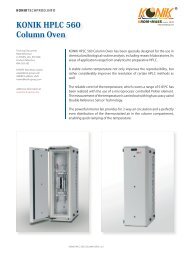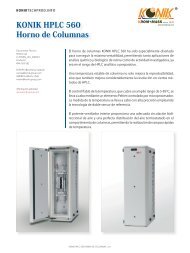Konik Consumables Catalogue_redistribucion y capitulos 1 y 2 ...
Konik Consumables Catalogue_redistribucion y capitulos 1 y 2 ...
Konik Consumables Catalogue_redistribucion y capitulos 1 y 2 ...
Create successful ePaper yourself
Turn your PDF publications into a flip-book with our unique Google optimized e-Paper software.
GC CAPILLARY & PACKED COLUMNS<br />
Internal Diameter<br />
The column internal diameter is inversely proportional to its separation power. The smaller the<br />
diameter, the larger the efficiency and thus a higher resolution but at the same time the loading<br />
capacity decreases.<br />
For samples containing a large number of substances where you may need a given resolution, it is<br />
recommended to use small internal diameter columns (0.20-0.25 mm) and for samples with a high<br />
range of concentrations higher internal diameter columns are recommended (0.32-0.53 mm) since<br />
these larger diameters allow for the injection of a higher sample amount.<br />
Columns of 0.53 mm ID (semicapillary) have a loading capacity similar to that of packed columns,<br />
which they replace in many analyzes, with better resolution, higher chemical inertness and lower<br />
analysis time.<br />
The 0.32-0-53 mm ID columns can be used with either the injector for capillary columns or with the<br />
packed column injector, due to the high ow-rates at which they can operate.<br />
In the increasingly used GC-MS systems it is recommended to work with small ID columns (0.10mm,<br />
0.15mm, 0.18mm, 0.20 mm and 0.22 mm) so as not to exceed the capacity of the vacuum system.<br />
Recently, capillary columns of 0.1 mm ID have appeared on the market.<br />
These generate high plate numbers or, in other words, to reduce analysis time without losing<br />
resolution. The high efficiency of these columns (7000-10000 plates/meter) allows the resolution<br />
of complex samples using shorter column lengths, thus with very short analysis times, with the<br />
resulting cost reduction for the laboratory. Evidently, their loading capacity is a limiting factor<br />
and in order to obtain the best performance from these columns we need to take into account<br />
instrumental factors (injector-detector).<br />
Film Thickness<br />
The lm thickness of the stationary phase deposited inside the capillary column exerts an inuence<br />
on the number of effective theoretical plates that can be obtained with the column for a given<br />
separation, on its loading capacity, on the bleed level and on the elution temperature of a compound.<br />
A lm thickness of 0.25-0.32 mm is the standard thickness allowing for a compromise between<br />
loading capacity and resolution; and for the injection of samples with a wide volatility range.<br />
Thick lms increase retention of the most volatile components whereas thin lms provide faster<br />
elution at lower temperatures. As a general rule, thin lms (0.1 µm) must be used for compounds with<br />
a high molecular weight such as triglycerides, antioxidants, etc., which have elution temperatures<br />
over 300°C. Thick lms must be used for low boiling substances because thick lms increase the<br />
interaction between the substances and the stationary phase. Specically, 3-5 µm lms are used to<br />
separate solvents, gases, and very volatile substances at room temperature or lower.<br />
When the thickness of the stationary phase increases, thermal stability decreases, and thus the<br />
bleed level is higher which will limit the maximum operating temperature of the column.<br />
The ß factor denes the relation between the column internal diameter and the stationary phase<br />
thickness, thereby helping you to select the most appropriate column for your analysis.<br />
In addition, the ß factor allows for the easy exchange of columns since, for a given analysis with the<br />
same stationary phase, similar ß factors will result in the same or very similar retention times and<br />
capacity factors. Of course, this implies taking into account the column loading capacity (phase<br />
thickness and internal diameter).<br />
Cap. 1: 4<br />
<strong>Konik</strong>-Tech












